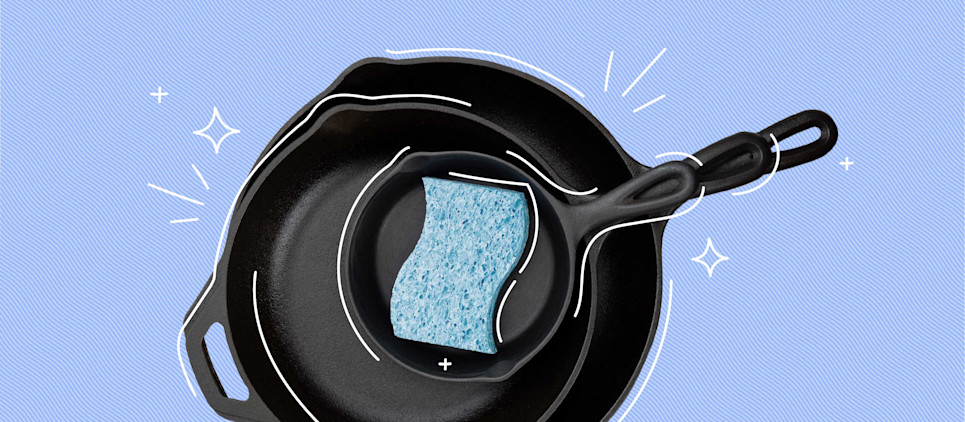How to clean and season cast iron pans so that they last forever
Cast iron cookware is a great value, and it can last for generations if taken care of properly. In general, maintaining your cast iron is all about cleaning it right after you cook a meal and following a simple seasoning process.
Once you practice a few times, cleaning and seasoning it after you cook will become a natural routine. Luckily, even if you neglect your cast iron a bit, or inherit a pan that needs reviving, you can bring it back to life by reseasoning.

Table of contents
How to maintain your cast iron panWhat does seasoning mean?How to clean and season a cast iron pan How to get rid of rustHow to maintain your cast iron pan
The purpose of maintaining cast iron is to keep its naturally nonstick surface intact and prevent your pan from forming any rust. If you stick to your routine of cleaning and seasoning after each time you use your pan, you shouldn’t ever need to do a full reseasoning. However, you can do an optional more intense seasoning in the oven—a great maintenance step to do once a year even if you aren’t seeing any signs of rust or a blotchy cooking surface.
What does seasoning mean?
Seasoning is a simple post-cleaning step where you buff a thin layer of oil into the pan over heat to continue the bonding process and maintain an ideal cooking surface.
A well-maintained cast iron pan is a well-seasoned cast iron pan. Most new cast iron cookware comes pre-seasoned, which means that it has been treated so that the oil has bonded to the natural iron in the pan and created a slightly slick cooking surface. A little bit of everyday (or every time you cook) seasoning will build a better and better cooking surface over time.
How to clean and season a cast iron pan
For a basic cleaning after each use, follow these steps to clean your cast iron skillet, dutch oven, or griddle:
Run under hot water and remove any food particles with a nonmetal, non-abrasive scrub brush or sponge.
Dry thoroughly right after you clean—do not let your cast iron air dry.
Set on the stove over medium heat to evaporate any remaining water.
Rub with a thin coat of vegetable oil (about a ½ teaspoon for a 10 inch skillet) until evenly coated and shiny.
Let cool completely and store in a dry place.
Tip: Avoid using steel wool or running the pan through the dishwasher, as either could strip the seasoning you’ve so diligently maintained!
Tip: It’s fine to use a small amount of dish soap, just make sure you season it immediately after cleaning as the soap will act like a degreaser and pull out all of the oil.
How to do an intensive reseasoning
After you clean a cast iron pan, it’s essential to season your pan immediately after, but you can also do a more intensive reseasoning process in the oven. This is just a longer version of the quick seasoning that follows every cleaning.
You can also follow this process to restore cast iron that is looking dull or blotchy on the cooking surface. Depending on the condition of the pan, you may need to repeat this process up to 6 times to completely restore it.
First scour under hot water with a nonmetal, non abrasive scrub brush or sponge to remove as much of the blotchiness as possible.
Dry thoroughly right after you clean—do not let your cast iron air dry.
Thoroughly coat with vegetable oil inside and out. Use a little more oil than you would for seasoning after cleaning.
Place upside down on a rack in the oven and line the track beneath it with foil to catch any oil drips.
Bake at 350° for one hour, then remove and allow to cool completely.
Tip: To let everyone know there is a hot pan on the stove and to prevent anyone from grabbing the still-hot handle, drape a dish towel over the handle while it cools.
How to get rid of rust
For minimal rust, scouring pads and elbow grease should do the trick. If after scrubbing you’re still noticing patches of rust or a blotchy looking cooking surface, follow the steps for reseasoning a pan and repeat as many times as needed to restore it to its full glossy shine.
Tip: If you aren’t sure if your pan needs a good reseasoning, try the fried egg test. Add ½ of cooking oil to your pan and fry an egg. A well-seasoned pan will fry eggs with minimal sticking.
Bungalow offers private rooms in shared homes that are more affordable than solo housing options in the same neighborhoods. Wifi, utilities, and monthly cleaning are set up before you move in so that coliving is seamless. Bungalow kitchens come with everything you need to cook your first meal—and they’re the perfect home for your cast iron pans. Find a Bungalow near you.
Ready to find your next home?
Move-in ready homes and a built-in community so you can feel at home, together — wherever you are.
Suggested articles



